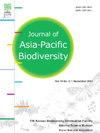气候变化情景预测了兴都库什-喜马拉雅地区中草虫草(Ophiocordyceps sinensis, Berk.)适宜栖息地的减少和范围的转移
IF 0.7
Q4 BIODIVERSITY CONSERVATION
引用次数: 0
摘要
在过去的50年里,兴都库什喜马拉雅地区的人为气候变暖速度比全球平均速度要快。自20世纪80年代以来,该地区经历了强烈的气候事件,特别是海拔依赖型变暖。鉴于其独特的进化背景、丰富的物种多样性和显著的地方性,了解气候变化对该地区物种分布的影响至关重要。尤其令人感兴趣的是真菌,尽管它们可能在生态系统的功能和稳定中发挥着重要作用,但它们如何应对气候变化的研究却少得多。因此,我们选择冬虫夏草(Ophiocordyceps sinensis)作为高山真菌,预测气候变化对其在兴都库什-喜马拉雅地区分布的影响。作为东方医学中最昂贵的天然资源之一,虫草及其周围栖息地正受到各种生态和人为因素的威胁。利用物种分布建模软件Maxent 3.3.4和一组不相关的气候(温度和降水)和地形(海拔、坡度和坡向)变量,在2.5弧分的空间分辨率下对适宜生境进行建模。利用BCCCSM2- HR全球环流模型的未来气候数据,对共享社会经济路径(SSP126、SSP245和SSP585)的3种排放情景进行了预测。Maxent模型对当前和未来生境的预测精度较高。目前中华按蚊潜在分布图显示,印度、中国、尼泊尔和不丹是中华按蚊的高适宜区。所有三种情景下的预测图显示,与目前的气候条件相比,适宜栖息地大幅减少。在气候变化情景下,物种的活动范围既有扩张,也有收缩。范围缩小明显大于范围扩大,导致中华圆叶蝉适宜生境总体减少。“质心范围偏移”分析表明,在质心几乎重叠的所有未来情景下,潜在的适宜栖息地都将向西南方向移动。本文章由计算机程序翻译,如有差异,请以英文原文为准。
Climate change scenarios predict reduction in suitable habitats and range shifts for Ophiocordyceps sinensis (Berk.) in Hindu Kush Himalaya
The Hindu Kush Himalayan region has seen a faster pace of anthropogenic climate warming than the global average during the last 50 years. Since the 1980s this region has been experiencing intense climatic events, notably elevation-dependent warming. Given its unique evolutionary background, rich variety of species, and significant endemism, it is crucial to comprehend the effects of climate change on species distributions in this area. Of particular interest are the fungi, which have been the subject of much fewer studies on how they will respond to climate change, despite the fact that they may have a significant role in the functioning and stability of ecosystems. We therefore selected Ophiocordyceps sinensis an alpine fungus species for predicting the effects of climate change on its distribution in Hindu Kush Himalaya. Regarded as one of the most expensive natural resources used in oriental medicine, Ophiocordyceps and its surrounding habitats are under threat from various ecological and anthropogenic factors. We used species distribution modeling software Maxent 3.3.4 and a set of uncorrelated climatic (temperature and precipitation) and topographical (elevation, slope, and aspect) variables at a spatial resolution of 2.5 arc minutes to model the suitable habitats. To predict the future distribution of O. sinensis we used future climate data from BCCCSM2- HR global circulation model for three emission scenarios of the shared socioeconomic pathways (SSPs) (SSP126, SSP245 and SSP585). Maxent model predicted current and future habitats with high accuracy. Current potential distribution map of O. sinensis shows that high suitability areas occur in India, China, Nepal, and Bhutan. Prediction maps under all three scenarios showed a large reduction in suitable habitats as compared to current climatic conditions. Analysis of range change reveals that species exhibit both range expansion and range contraction under climate change scenarios. Range contraction is noticeably more than range expansion, causing an overall reduction in the suitable habitats occupied by O. sinensis. “Centroid Range Shift” analysis revealed potential suitable habitats will shift to the southwest direction under all future scenarios with almost overlapping centroids.
求助全文
通过发布文献求助,成功后即可免费获取论文全文。
去求助
来源期刊

Journal of Asia-Pacific Biodiversity
Agricultural and Biological Sciences-Insect Science
CiteScore
1.70
自引率
12.50%
发文量
94
审稿时长
27 days
期刊介绍:
The Journal of Asia-Pacific Biodiversity (previous title was Journal of Korean Nature) is an official journal of National Science Museum of Korea (NSMK) and Korea National Arboretum (KNA). The scope of journal is wide and multidisciplinary that publishes original research papers, review articles, as well as conceptual, technical and methodological papers on all aspects of biological diversity-its description, analysis and conservation, and its application by humankind. This wide and multidisciplinary journal aims to provide both scientists and practitioners in conservation theory, policy and management with comprehensive and applicable information. However, papers should not be submitted that deal with microorganisms, except in invited paper. Articles that are focused on the social and economical aspects of biodiversity will be normally not accepted.
 求助内容:
求助内容: 应助结果提醒方式:
应助结果提醒方式:


